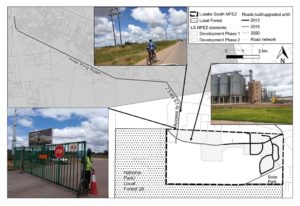This blog was written for the RSA Blog Student Summer Series that will highlight graduate student success in regional studies across the globe throughout the summer.
Choose a strategically located area, provide reliable infrastructure, fiscal, and regulatory incentives – and the investors will come, leading to regional development and industrialization. This is the recipe for so called Special Economic Zones (SEZs) that have been promoted all over the Global South in the last few decades, for example, the Lusaka South Multi-Facility Economic Zone in Zambia (see image below). But are SEZs really such effective instruments to promote integrated regional development, or as some believe, are SEZs simply ‘enclaves’ which are segregated from their host region? Opinions are controversial and to understand this divergence, we have looked closely at different conceptual perspectives regarding SEZs.

The Lusaka South Multi-Facility Economic Zone in Zambia. Photographs and map design by Carolina Kiesel.
SEZs as Enclaves
When SEZs are seen from a spatial perspective, they are often regarded as enclave spaces, segregated from their surroundings. While an enclave per se may not be a problem and can indicate a very successful SEZ regarding foreign direct investment (FDI) attraction and export earnings, the term is often used to depict undesired social and environmental externalities of SEZs. With their international firms, industrial production spaces and real estate developments, some SEZs form a parallel world of money, modernity, and internationalization in contrast to surrounding poor rural villages or neighbourhoods. The enclave character also goes beyond those spatially apparent characteristics: Because of their institutional particularities such as tax breaks and laxer regulatory frameworks, SEZs are often called deregulated, state-absent “exceptional spaces”. Their often export-oriented character furthermore speaks for little trade linkages to the local economy, which is also a sign for a non-integrated enclave.
Integrative SEZs and their potential linkages to the host region
The enclave perspective stands in opposition to what the SEZ concept aims to achieve. SEZs can form significant linkages and integrate into their host region, e.g. through employment creation and urbanization effects because of the infrastructural development in and around the SEZs. Given a proper strategic policy orientation, SEZ firms can become locally embedded and establish trade networks to local suppliers and distributors, which can go hand in hand with knowledge and technology transfer.
There is an extensive body of conceptual literature supporting this integrative point of view, from theories on linkages to production networks. This literature also focuses on value creation and capture which enables economic development and industrialization of the SEZ host countries.
So many aspects to consider…
… and thusly so many ways SEZs can be looked at, leading to different findings about even one and the same SEZ. Some SEZ studies regard, for example, resource flows, others focus on labour market and general economic effects, and others – including enclave studies – concentrate on the institutional settings.
Here are some examples: Giannecchini and Taylor question the spillover effects of the Eastern Industrial Zone for Ethiopia’s economy, while Fei and Liao show how in this particular zone, Chinese companies are embedded in the local context through the many employed Ethiopian workers. In the case of Zambian copper mining, partly operated through a Chinese SEZ, Carmody and Hampaye criticize exclusionary features and the creation of a hybrid economy, in which informal practices coexist with the formal economy. Nonetheless, Fessehaie and Morris question the enclave nature by disclosing value chain linkages to local Zambian suppliers. SEZs in India are often framed as enclaves due to weak spillover effects and land grab conflicts. However, Cross reveals that their institutional settings and social impacts are as precarious as in the rest of the country, so they do not represent an ‘enclavistic’ exception.
These examples show how the focus on different aspects of SEZ may result in differing findings about one and the same SEZ.
Different foci in particular SEZ studies resemble the ‘blind men and the elephant’ challenge, wherein each perspective per se is right, but only constitutes part of the whole problem.
There is a multiplicity of ways through which SEZs may be (dis)connected to their local contexts, which require closer and holistic attention to understand the integrative and enclave developments of SEZs. Neither an overly positive view – which sees the SEZ concept as the most promising instrument for regional development – nor a very skeptical view on SEZs as enclaves is very helpful. Instead, our findings point to the different and partly ambivalent nature of SEZs, calling for a nuanced approach in future studies.
*We thank our key partner Enock Sakala from University of Zambia for the cooperation in our research.

Carolina Kiesel (LinkedIn; Twitter) is a research fellow and doctoral candidate at the Institute of Geography, University of Cologne, Germany. She is working on the research project “Between Enclaves and Integration – Chinese and African Special Economic Zones in Sub-Saharan Africa” (Homepage), which is being funded by the German Research Foundation (DFG). Contact: carolina.kiesel@uni-koeln.de.

Peter Dannenberg (Twitter) is a full professor for Human Geography at the Institute of Geography, University of Cologne, Germany.
Are you currently involved with regional research, policy, and development? The Regional Studies Association is accepting articles for their online blog. For more information, contact the Blog Editor at rsablog@regionalstudies.org.